Global climate change
Before really delving into a discussion of climate change, we have to begin with some clarification of terms: weather vs climate and global warming vs climate change. All of these terms relate to atmospheric conditions, specifically temperature, but understanding the differences is crucial to understanding climate change.
Many of us check the weather every day. This automatically indicates that weather is something that changes frequently. When we watch a storm move in across the ocean, feel the humidity after a rainstorm or feel the temperature cool in the evening, we are observing a change in the weather. Weather is the atmospheric conditions, temperature, humidity, precipitation, wind speed and more, at a specific location at a specific time. Climate is the long-term average of these conditions, often at the regional or larger scale. Single days, weeks, or even years that are hotter than normal or rainier than normal, do not indicate a change in climate. However, a long-term trend of changes in temperature and/or precipitation do indicate a change in climate.
Global warming is a change in climate but is not synonymous with climate change. Global warming just refers to the trend of increasing global temperatures (we will talk about evidence of this in a minute). Global warming is a part of climate change, but climate change includes changes in precipitation and extreme events such as droughts and heat waves. Both terms are appropriate as long as they are used correctly. For a more thorough discussion of global warming vs. climate change, read this article from Skeptical Science.
How do we know that climate is changing?
Climate has always been changing, but the changes we are currently seeing are unprecedented. Measuring the weather at a given location is fairly easy, but studying long-term changes in climate is more difficult, especially because we only have direct measurements with modern, or reasonably modern, instruments for about the last 100-150 years, with most weather stations in the United States established in the 1800’s. Because of this, climate researchers must use direct and indirect measurements to look at long-term patterns in climate.
When scientists need to examine climate from time periods before direct, recorded measurements of climate, they use climate proxies. For example, oxygen is found in both “light” and “heavy” forms on Earth, with the heavy forms having additional protons. The “heavy” form tends to form clouds and rain more easily than the “light” form does. Similarly, the “light” form evaporates more easily. Because of this, the two forms of oxygen accumulate differently in ocean water and in land ice depending on the temperature. Scientists can then use oxygen trapped in ocean sediments and ice cores to determine past climate. Scientists can also use evidence from coral reefs, which have rings indicating years of growth. Because coral grow faster in warm water, the width of these rings can be used to reconstruct past climate. These reconstructions of past climate are not simple, but the overwhelming evidence, from both modern measurements and reconstruction of past climate, is that climate is rapidly changing.
Our evidence of climate change includes warming global temperatures, increasing ocean temperatures, shrinking glaciers and sea ice, declining snow cover, sea level rise, and increasing frequency of extreme events
Warming global temperatures
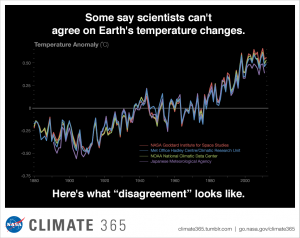
Within this trend of warming, we see periods in which the climate appears to be cooling. For example, the global average temperature in 2018 was lower than the global average temperature in 2017, which was lower than the global average temperature in 2016. However, when this small piece of data is viewed in the context of long-term climate data, the warming trend is clear as seen in the video below (Credit: NASA/JPL-Caltech).
Increasing ocean temperatures
The changes in temperature are not evenly distributed across the globe and one
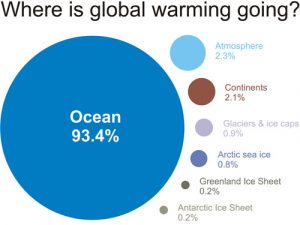
and one area of particular concern is the warming oceans. Not only do the oceans cover about 70% of the Earth’s surface, the oceans are also highly effective at absorbing heat with relatively small changes in temperature. This ability to absorb heat is related to the heat capacity of water and, along with the latent heat, is a significant part of the oceans’ role in stabilizing the Earth’s climate. Heat capacity is the amount of energy required to increase the temperature of a substance by 1°C and is standardized by the mass of the substance to give specific heat. For example, if the specific heat is 1000 J/(kg °C), this means that it takes 1,000 J (a unit of energy) to increase the temperature of 1 kg of the material by 1°C. The specific heat of water is much greater than the specific heat of other materials commonly found on the Earth’s surface (Table 1). Over 90% of the heat absorbed by the Earth in the last 50 years has been absorbed by the oceans, with most of the heat absorbed in the upper ocean (0-700 m deep). The upper ocean has warmed by about 0.2°C since 1969. This temperature increase is much smaller than the increase in temperature we have seen for the Earth as a whole, but represents a large amount of heat energy. A rough estimate of the amount of heat energy absorbed by the upper ocean during this time is 2 x 1023 J, or 2,000 times the total energy use of the United States in 2019 (see Box 1). While the temperature change in the ocean is smaller than the temperature change on land, the amount of energy required to produce this temperature change is clear evidence of a changing climate.
| Material | Specific heat (J/(kg °C)) |
| Air (dry, sea level)
Asphalt Granite Ice (snow, -5°C) Sand, quartz Soil,dry |
1005
920 790 2090 830 800 |
| Soil, wet | 1480 |
| Seawater (20°C) | 4007 |
Sea level rise
The increasing ocean temperatures are closely related to sea level rise. While we know that water continuously cycles around the world, and that the overall quantity of water on Earth will not change due to global climate change, the distribution of this water is changing. In particular, oceans are increasing in volume while land ice stores (such as glaciers) are decreasing. This contributes to an increase in sea level worldwide.
Sea level has increased at an average of 0.06 inches (0.15 cm) per year from 1880-2014. Most of this rise, however, has occurred within the most recent decades. The rate of increase has gone up to between 0.11 to 0.14 inches (0.28 to 0.36 cm) per year since 1993. There are two forces causing sea level to rise, both caused by climate change. First, the increased global temperature has caused increased ice melting in many regions of the globe. Melting land ice contributes to sea level rise because water that used to be stored in ice sitting on top of land becomes running water which reaches the ocean through runoff. We also observe sea ice melting (see http://www.epa.gov/climatechange/ science/indicators/index.html for data and figures). Sea ice, such as the ice that covers the arctic regions of the Northern Hemisphere, has no land underneath it. When it melts, the overall sea level does not change because the sea ice was already displacing ocean water of the same volume as the water it becomes when it melts. You can read and here more about land ice and sea ice at https://yaleclimateconnections.org/2014/11/loss-of-land-ice-not-sea-ice-more-sea-level-rise/.
The second factor that influences sea level rise is a phenomenon called thermal expansion. Due to the physical properties of water, as water warms, its density decreases. A less dense substance will have fewer molecules in a given area than a more dense substance. This means that as the overall temperature of the oceans increases due to global climate change, the same amount of water molecules will now occupy a slightly larger volume. This may not seem significant, but considering the 1.3 billion trillion liters (264 billion gallons) of water in the ocean, even a small change in density can have large effects on sea level as a whole.
Scientists have already documented sea level rise in some areas of the world, including one familiar to most of us: the Southeastern United States. The figure below depicts the measured land area lost due to increasing sea level since 1996. This graph shows the net amount of land converted to open water along the Atlantic coast during three time periods: 1996–2001, 1996–2006, and 1996–2011. The results are divided into two regions: the Southeast and the Mid-Atlantic. Negative numbers show where land loss is outpaced by the accumulation of new land. Note that the Southeast (defined here as the Atlantic coast of North Carolina south to Florida) is particularly susceptible to land area loss due to the gently sloping nature of our coastline. Moving northward into the Mid-Atlantic States (defined here as Virginia north to Long Island, New York), coastal habitats tend to have a steeper geography, which protects against some losses.
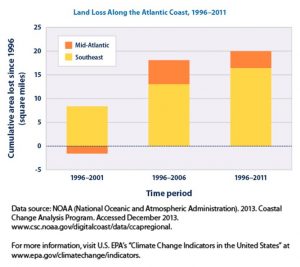
While the ecological effects of sea level rise remain in the United States, we don’t project any catastrophic loss of life, property, or livelihood for some time. This is, in part, due to large investments that we have made in infrastructure to protect our cities and farmlands. This is not the case in many areas of the world. For a discussion of the impacts of sea level rise on less-industrialized nations of Bangladesh, Maldives, Kiribati, and Fiji, review the required article reading.
Ocean acidification
Dissolved CO2 is essential for many organisms, including shell-building animals and other organisms that form a hard coating on their exterior (e.g., shellfish, corals, Haptophyte algae). This hard coating is built out of aragonite, a mineral form of the molecule calcium carbonate, CaCO3. These organisms rely on the formation of carbonate ions , CO32-, from dissolved CO2, through a natural, chemical reaction that occurs. This takes place through a chain-reaction equation, where bicarbonate (HCO3-) is formed as an intermediate, and hydrogen ions (H+) are generated (equations 6.3 and 6.4).
CO2 + H2O ↔ H+ + HCO3− Eq. 6.3
HCO3− ↔ H+ + CO32− Eq. 6.4
To have a better visualization of this process, follow along with the interactive graphic at:
http://www.whoi.edu/home/oceanus _images/ries/calcification.html.
As you can see, both equations 6.3 and 6.4 each produce one H+. This is significant to water chemistry because an increase in H+ concentration means a decrease in the pH of the water. You can see in Figure 6.18 that a lower pH means that the liquid is more acidic. As shown in the interactive graphic, an increase in CO2 in the atmosphere causes additional CO2 to be dissolved in the ocean. This means that more CO2 in the atmosphere leads to more acidic ocean environments.
Unfortunately for shell-building animals, the buildup of H+ in the more acidic ocean environment blocks the absorption of calcium and CO32-, and makes the formation of aragonite more difficult. An aragonite deficit is already being documented in many of the world’s oceans, as shown below. This map shows changes in the aragonite saturation level of ocean surface waters between the 1880s and the most recent decade (2004–2013). Aragonite is a form of calcium carbonate that many marine animals use to build their skeletons and shells. A negative change represents a decrease in saturation.
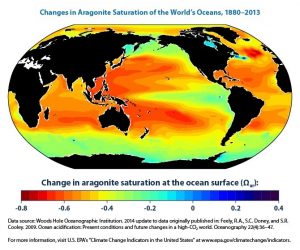
The increasing acidity of the world’s oceans is resulting in habitat changes across the globe. This is only expected to worsen as atmospheric CO2 levels continue to increase. Many organisms, including the corals that are the foundation species of the beautiful coral reefs, are very sensitive to changes in ocean pH. Scientists have documented cases of ecosystem destruction through coral bleaching, caused by the effects of climate change including ocean acidification and increased temperature. For more information, visit the NOAA Coral Reef Conservation Program website: http://coralreef.noaa.gov/threats/climate/.
What is causing global climate change?
Scientists have identified the source of our current global climate change as being the increased human-caused emissions of greenhouse gases such as carbon dioxide (CO2), methane (CH4), and nitrous oxide (N2O), since the industrial revolution. Greenhouse gases are defined as large (at least three atoms) gas molecules that participate in the greenhouse effect. While you already know about the “big three” greenhouse gases (CO2, CH4, and N2O), it’s important to realize that water vapor (H2O) is also a greenhouse gas. While humans have little direct impact on water vapor concentrations in the atmosphere, is it still an essential component of the natural greenhouse effect that occurs in our atmosphere.
The Earth receives energy from the sun and in turn radiates energy back into space. When these two energies are equal, a stable temperature of the Earth is achieved. This temperature can be calculated from basic physics and is equal to about -18°C (0°F). This thermal equilibrium temperature is obviously much colder than that of the surface of the Earth. The actual average value of the Earth’s surface temperature is about 15°C (59°F). The difference between these temperatures is due primarily to the natural greenhouse gas concentrations in the atmosphere, causing the greenhouse effect. If the Earth had no naturally occurring atmospheric greenhouse gases, the temperature at the surface of the Earth would equal the thermal equilibrium temperature. The influence of these greenhouse gases, mainly water and some CO2, moderates the Earth’s climate and makes life possible.
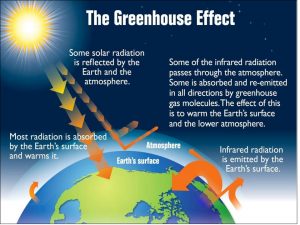
As solar radiation reaches the Earth’s atmosphere, there are a variety of possibilities for its fate. Some solar radiation is reflected by the Earth and its atmosphere, and does not contribute to warming. Some passes through the atmosphere and reaches the surface of the Earth. When this solar radiation is absorbed by objects on Earth’s surface, it is re-emitted as infrared radiation (heat) that escapes to space. However, some of this heat is intercepted in the atmosphere by greenhouse gases. These gases absorb and re-emit the radiation in all directions. This creates a warming impact on the Earth’s surface Radiation can be bounced around from one greenhouse gas molecule to another, becoming trapped, and increasing its warming potential. For this reason, an increased greenhouse gas concentration causes an increase in the overall warming potential of the Earth’s atmosphere.
On a geological time scale, the climate has changed many times in the past, even before the presence of humans. These changes occurred naturally because man had not yet evolved. A well-known example of past climate change is the occurrence of ice ages. Ice ages have occurred repeatedly throughout Earth’s history, the most severe ice age of which scientists have reliable data occurred around 650,000 years ago. During this time, solid, glacial ice covered much of Canada, the northern United States, and northern Europe; the level of the ocean decreased 120 m, and the global average temperature decreased by 5°C. A geologic history of ice events is preserved in the ice sheets 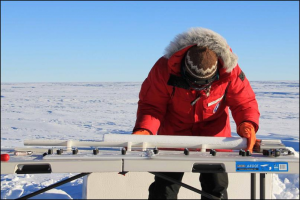 covering Antarctica and Greenland. This history has been uncovered over the past decades by scientists who have cored deeply into the ice and deciphered the temperature and atmospheric composition records stored in the ice. This process of obtaining ice cores is shown on the left. On Dec. 8, 2010, Michelle Koutnik, of the University of Copenhagen’s Center for Ice and Climate, prepared a core of Antarctic ice to be wrapped and put into core tubes for transport back to labs at Brigham Young University in Utah. But first, Koutnik measured the core’s length, diameter and weight. The traverse was the first of two field campaigns to study snow accumulation on the West Antarctic Ice Sheet and tie the information back to larger-scale data collected from satellites (photo credit: NASA/Lora Koenig). The temperature at which the ice originally formed can be obtained from an interpretation of the measured ratio of the stable isotopes of oxygen in the molecules of water forming the ice. The atmospheric gas composition is taken from air bubbles trapped in the ice at the time of formation. From these data, scientists have gathered a set of reliable data that track atmospheric temperature and gas concentrations that dates back 800,000 years. These data helped scientists come to the conclusion that the Earth’s temperature and greenhouse gas concentrations are directly correlated to one another. During the ice age 650,000 years ago, the Earth was experiencing depressed temperature and atmospheric CO2 concentrations below 200 parts per million (ppm). We can also see from the data below, that CO2 concentrations can be naturally elevated to
covering Antarctica and Greenland. This history has been uncovered over the past decades by scientists who have cored deeply into the ice and deciphered the temperature and atmospheric composition records stored in the ice. This process of obtaining ice cores is shown on the left. On Dec. 8, 2010, Michelle Koutnik, of the University of Copenhagen’s Center for Ice and Climate, prepared a core of Antarctic ice to be wrapped and put into core tubes for transport back to labs at Brigham Young University in Utah. But first, Koutnik measured the core’s length, diameter and weight. The traverse was the first of two field campaigns to study snow accumulation on the West Antarctic Ice Sheet and tie the information back to larger-scale data collected from satellites (photo credit: NASA/Lora Koenig). The temperature at which the ice originally formed can be obtained from an interpretation of the measured ratio of the stable isotopes of oxygen in the molecules of water forming the ice. The atmospheric gas composition is taken from air bubbles trapped in the ice at the time of formation. From these data, scientists have gathered a set of reliable data that track atmospheric temperature and gas concentrations that dates back 800,000 years. These data helped scientists come to the conclusion that the Earth’s temperature and greenhouse gas concentrations are directly correlated to one another. During the ice age 650,000 years ago, the Earth was experiencing depressed temperature and atmospheric CO2 concentrations below 200 parts per million (ppm). We can also see from the data below, that CO2 concentrations can be naturally elevated to 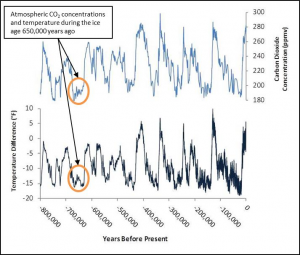 as high as 300 ppm, correlating with increased temperatures. These estimates of the Earth’s changing CO2 concentration (top) and Antarctic temperature (bottom) are based on analysis of ice core data extending back 800,000 years. Until the past century, natural factors caused atmospheric CO2 concentrations to vary within a range of about 180 to 300 ppm. Warmer periods coincide with periods of relatively high CO2 concentrations. NOTE: The past century’s temperature changes and rapid CO2 rise (to 400 ppm in 2015) are not shown here (Source: Based on data appearing in NRC (2010)).
as high as 300 ppm, correlating with increased temperatures. These estimates of the Earth’s changing CO2 concentration (top) and Antarctic temperature (bottom) are based on analysis of ice core data extending back 800,000 years. Until the past century, natural factors caused atmospheric CO2 concentrations to vary within a range of about 180 to 300 ppm. Warmer periods coincide with periods of relatively high CO2 concentrations. NOTE: The past century’s temperature changes and rapid CO2 rise (to 400 ppm in 2015) are not shown here (Source: Based on data appearing in NRC (2010)).
The 100,000 year major cycle of the ice ages and some variations within the cycles agree very well with predicted periodic relationships between the Earth’s orbit around the sun, generally referred to as the Milankovitch cycles. Milankovitch cycles describe the very slight “wobbles” that occur in the Earth’s tilt and path as it moves around the sun. The Earth is always slightly tilted on its axis with respect to the sun. The angle of this tilt, however, changes periodically, varying from about 22° to about 25°. A less severe tilt will cause milder summers and winters close to the poles, preventing full summer ice melt in the northern- and southernmost regions, and allowing for a buildup of ice from year to year.
The path through which the Earth travels on its journey around the sun also changes from a more circular to a more elongated shape. Again, a round orbit will cause milder summers and winters close to the poles. These are very long term changes, and the results of the Milankovitch cycles can be observed in the changes in temperature and atmospheric CO2 concentration shown in Figure 6.8. The climate change event that scientists are currently documenting is occurring much more rapidly than could be explained by Milankovitch cycles. Therefore, scientists agree that the cause of our currently changing climate is due to human impacts and not natural forces.
Greenhouse gases
We will be covering the four major categories of greenhouse gases that have been impacted by humans the most.
- Carbon dioxide, CO2
- Methane, CH4
- Nitrous oxide, N2O
- Synthetic fluorinated gases, including hydrofluorocarbons (HFCs), perfluorocarbons (PFCs), and sulfur hexafluoride (SF6)
Carbon dioxide (CO2) is the greenhouse gas responsible for most of the human-caused climate change in our atmosphere. It has the highest concentration in the atmosphere of any of the greenhouse gases that we’ll discuss here. Remember that CO2 is a direct product of both combustion and cellular respiration, causing it to be produced in great quantities both naturally and anthropogenically. Any time biomass or fossil fuels are burned, CO2 is released. Major anthropogenic sources include: electricity production from coal-fired and natural gas power plants, transportation, and industry. To get an idea of how CO2 concentration has changed over time, watch this video compiled by the National Oceanic and Atmospheric Administration (NOAA): http://www.esrl.noaa.gov/gmd/ccgg/trends/history.html. This video contains atmospheric CO2 concentrations measured directly, dating back to 1958, as well as atmospheric CO2 concentrations measured indirectly from ice core data, dating back to 800,000 BCE. By 1990, a quantity of over seven billion tons of carbon (equivalent to 26 billion tons of carbon dioxide when the weight of the oxygen atoms are also considered) was being emitted into the atmosphere every year, much of it from industrialized nations. Similar to the action of the naturally existing greenhouse gases, any additional greenhouse gases leads to an increase in the surface temperature of the Earth.
While CO2 is produced by aerobic cellular respiration, gases such as CH4 and N2O are often the products of anaerobic metabolisms. Agriculture is a major contributor to CH4 emissions. In addition to anaerobic bacteria, methane is also a significant component of natural gas, and is commonly emitted through the mining and use of natural gas and petroleum, in addition to coal mining. Finally, landfills contribute significantly to CH4 emissions, as the waste put into the landfill largely undergoes anaerobic decomposition as it is buried under many layers of trash and soil. Natural sources of CH4 include swamps and wetlands, and volcanoes.
The vast majority of N2O production by humans comes from agricultural land management. While some N2O is naturally emitted to the atmosphere from soil as part of the nitrogen cycle, human changes in land management, largely due to agricultural practices, have greatly increased N2O emissions. Some N2O is also emitted from transportation and industry.
Due to their relatively high concentrations in the 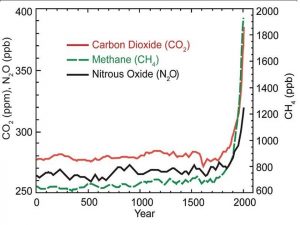 atmosphere compared to synthetic gases, CO2, CH4, and N2O, are responsible for most of the human-caused global climate change over the past century. The figure at right shows the increases in all three gases following the industrial revolution. Overall it shows an increase in greenhouse gas concentrations in the atmosphere over the last 2,000 years. Increases in concentrations of these gases since 1750 are due to human activities in the industrial era. Concentration units are parts per million (ppm) or parts per billion (ppb), indicating the number of molecules of the greenhouse gas per million or billion molecules of air (Source: USGCRP (2009)). Ice core data (earlier figure) shows us that the atmospheric CO2 concentration never exceeded 300 ppm before the industrial revolution. As of early 2015, the current atmospheric CO2 concentration is 400 ppm. Comparing these figures, what is likely to happen to global temperature following this unprecedented rise in greenhouse gas levels?
atmosphere compared to synthetic gases, CO2, CH4, and N2O, are responsible for most of the human-caused global climate change over the past century. The figure at right shows the increases in all three gases following the industrial revolution. Overall it shows an increase in greenhouse gas concentrations in the atmosphere over the last 2,000 years. Increases in concentrations of these gases since 1750 are due to human activities in the industrial era. Concentration units are parts per million (ppm) or parts per billion (ppb), indicating the number of molecules of the greenhouse gas per million or billion molecules of air (Source: USGCRP (2009)). Ice core data (earlier figure) shows us that the atmospheric CO2 concentration never exceeded 300 ppm before the industrial revolution. As of early 2015, the current atmospheric CO2 concentration is 400 ppm. Comparing these figures, what is likely to happen to global temperature following this unprecedented rise in greenhouse gas levels?
One class of greenhouse gas chemicals that has no natural sources is the fluorinated gases. These include HFCs, PFCs, and SF6, among others. Because these are synthetic chemicals that are only created by humans, these gases were essentially non-existent before the industrial revolution. These synthetic gases are used for a wide variety of applications, from refrigerants to semiconductor manufacturing, and propellants to fire retardants. They tend to have a long lifetime in the atmosphere, as seen in the table below. Some of these chemicals, as well as the older chlorofluorocarbons (CFCs), have been phased out by international environmental legislation under the Montreal Protocol. Due to their long lifespan, many of these now-banned CFCs remain in the atmosphere. Newer chemical replacements, such as HFCs, provide many of the same industrial applications, but unfortunately have their own environmental consequences.
Just as greenhouse gases differ in their sources and their residence time in the atmosphere, they also differ in their ability to produce the greenhouse effect. This is measured by the global warming potential, or GWP, of each greenhouse gas. The GWP of a greenhouse gas is based on its ability to absorb and scatter energy, as well as its lifetime in the atmosphere. Since CO2 is the most prevalent greenhouse gas, all other greenhouse gases are measured relative to it. As the reference point, CO2 always has a GWP of 1. Note the very high GWP values of the synthetic fluorinated gases in the table below. This is largely due to their very long residence time in the atmosphere. Also note the higher GWP values for CH4 and N2O compared to CO2.
Comparison of common greenhouse gases in the atmosphere. Data from US EPA. For more information: http://epa.gov/climatechange/ghgemissions/gases.html
| Greenhouse gas | Chemical formula or abbreviation | Lifetime in atmosphere | Global warming potential (100-year) |
| Carbon dioxide | CO2 | Variable | 1 |
| Methane | CH4 | 12 years | 28-36 |
| Nitrous oxide | N2O | 114 years | 298 |
| Hydrofluorocarbons | Abbreviation: HFCs | 1-270 years | 12-14,800 |
| Perfluorocarbons | Abbreviation: PFCs | 2,600-50,000 years | 7,390 |
| Sulfur hexafluoride | SF6 | 3,200 years | 22,800 |
Other climate influencers
In addition to greenhouse gases, other manmade changes may be forcing climate change. Increases in near surface ozone from internal combustion engines, aerosols such as carbon black, mineral dust and aviation-induced exhaust are acting to raise the surface temperature. This primarily occurs due to a decrease in the albedo of light-colored surfaces by the darker-colored carbon black, soot, dust, or particulate matter. As you know, it is more comfortable to wear a white shirt on a hot summer day than a black shirt. Why is this? Because the lighter-colored material bounces more solar radiation back toward space than the darker-colored material does, allowing it to stay cooler. The darker-colored material absorbs more solar radiation, increasing its temperature. Just as the white shirt has a higher albedo than the black shirt, light-colored objects in nature (such as snow) have a higher albedo than dark-colored objects (such as soot or dust). As humans increase the amount of carbon black, soot, dust, and particulates in the atmosphere, we decrease the albedo of light-colored surfaces, causing them to absorb more solar radiation and become warmer than they would without human influence.
Find out more in this article from the National Oceanic and Atmospheric Administration
Information in this chapter includes materials taken directly from and adapted from https://climate.nasa.gov/vital-signs/
The chapter also contains substantial content from Zehnder, Caralyn; Manoylov, Kalina; Mutiti, Samuel; Mutiti, Christine; VandeVoort, Allison; and Bennett, Donna, “Introduction to Environmental Science: 2nd Edition” (2018). Biological Sciences Open Textbooks. 4. You can download the original for free at https://oer.galileo.usg.edu/biology-textbooks/4/.
https://oer.galileo.usg.edu/biology-textbooks/4. That resource includes materials modified from OpenStax. Download for free at http://cnx.org/contents/5d263a29-7bd6-47bf-ad70-c233619bca33@3.
the atmospheric conditions, temperature, humidity, precipitation, wind speed and more, at a specific location at a specific time
Long term averages and variations within the conditions of the atmosphere.
a pattern of increasing temperatures over time (decades or more) that is seen over a large portion of the Earth. This term is often used to refer to this pattern as caused by increased emissions of greenhouse gases since the Industrial Revolution.
a long-term pattern of changes in temperature and precipitation, including changes in seasonality. This term is often used to refer to anthropogenic climate change, which is climate change caused by humans.
preserved physical characteristics that represent the past temperature and precipitation, such as tree rings and oxygen isotopes
slow moving masses of ice that form from accumulation of snow and ice through the years in areas cold enough to not have complete melting each year.
glaciers and ice sheets - this terem is used to differentiate between these types of ice and sea ice
water from precipitation that moves across the land surface, rather than soaking into the ground
frozen ocean water

